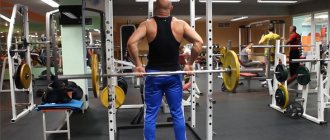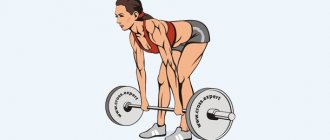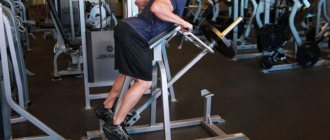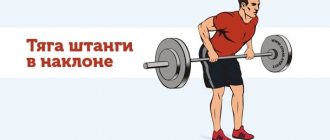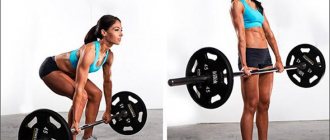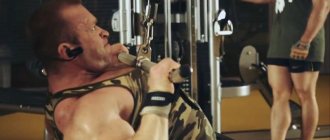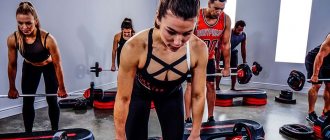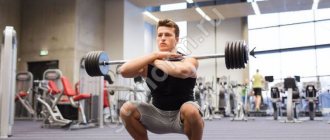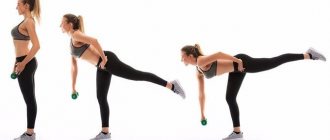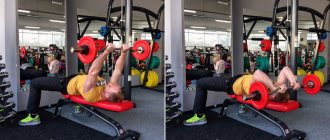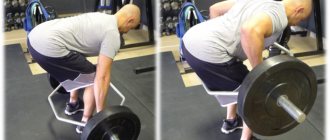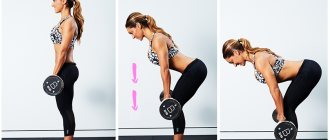Good day, dear athletes. Let's talk today about lagging muscles, that is, those that spoil the proportions of your aesthetic figure. Very often you can meet guys with broad shoulders, but their back part lags behind. This is especially noticeable when viewed from the side.
But even well-developed deltas are lost against the background of underdeveloped trapezoids. So why not solve two problems at once - pump up the rear deltoids and frame it all with powerful trapezoids. And the draft of Lee Haney will help us with this.
The benefits and harms of exercise
Should you do it? If you belong to the category of advanced amateurs or bodybuilding professionals, then it’s worth a try. If you are a beginner, then such a movement is of no use to you.
In general, as a beginner, stick to the simplest and most proven exercises!
Minuses:
- From an anatomical point of view, hyperextension of the shoulder is not natural for humans. Therefore, potentially dangerous.
- Not suitable for beginners due to difficult technique.
Pros:
- Works well on the rear deltoids and trapezius.
Contraindications
Invented by Lee Haney, the exercise is performed standing with a barbell or dumbbells. Moreover, the sports equipment is located behind the back. All this leads to an axial load on the spine.
In order for the bar to move freely along the buttocks and back of the thigh, you need to lean back slightly. Because of this, the load on the lower back increases.
Why am I telling this? And the spine and our shoulder girdle must be healthy, otherwise cravings should be avoided.
In particular, you should avoid it if you have diseases of the elbow and shoulder joints and osteochondrosis.
Execution technique and exercise options
Deadlifts, just like shrugs, can be performed with a barbell, dumbbells or in a Smith machine. The last option differs from the version with a barbell only in that it makes it easier to maintain balance. Let's consider options with free weights.
With dumbbells
The advantage of dumbbells is that they allow you to increase your range of motion. In addition, there is no need to tilt the body back.
Now for the technique:
- Take dumbbells in your hands and stand up straight.
- Move your hands with the dumbbells back so that they are behind and slightly to the side of your buttocks. The grip should be straight, that is, the palms are facing back.
- Pull your shoulders back. Keeping your back straight, pull your elbows up. The shoulder girdle does not rise at this moment.
- When lifting your arms up, bend at the elbow joint. Pay attention to your forearms, they should remain perpendicular to the floor.
- Pull the barbell up until it is level with your lower back.
- Pause at the top for a couple of seconds, then return to the starting position.
The exercise can be modified by performing dumbbell rows first with one arm and then with the other. This, firstly, will increase the amplitude of movement, and secondly, it will allow you to concentrate more on the muscles being worked, which is useful when working on weight.
With a barbell
The technique with a barbell has minor differences from the version with dumbbells, as well as some disadvantages, for example, a more limited amplitude.
How to perform barbell deadlifts:
- If you can just sit down and pick up dumbbells, this trick won’t work with a barbell. Therefore, it must first be installed on the racks of the power frame just above the knees.
- Come with your back to it, squat down slightly and grab the bar with an overhand grip (palms facing back).
- Pull the barbell up to your lower back.
To reinforce the technique, watch a video about how pros perform deadlifts.
Anatomy of the rear delts and how to train them
The rear delta is located on the back of the shoulder, that is, at the back of the back.
It starts from the lower edge of the scapula and, together with the other bundles, is attached to the tuberosity of the humerus. Its functions include:
- Retracting the arm back in any plane.
- Rotation (turn) of the hand outward (towards the thumb).
https://youtu.be/irjAlizO7a4
Knowing the function of the rear delts, we now understand the mechanics of their work and how to train them. That is, the main exercises for us will be all kinds of deadlifts with different weights: barbells, dumbbells, cable trainer. But the main thing that we must understand is that in pulling movements the back is actively working, in particular the lats and trapezius.
rear delt exercises
To begin with, we need to choose the optimal point where we will pull the training equipment we have chosen. Everything is simple here, if you consider that in any back exercises we pull the weight towards the belt, then when training the deltoids you will have to shift the emphasis closer to the chest. This will help eliminate the lats. I suggest, as a guide, to take the center of the pectoral muscles as that very point.
As for the position of the elbows. Basically, when training the rear deltas, the arms are held so that the elbows are in the same plane as the shoulders. That is, if we draw a horizontal line, then the elbows and rear delts will not go beyond it.
It shouldn't be too light. This way we will simply drown our muscles, but this will not lead to their increase. As for heavy weight, it is also not welcome. Because the deltas will not be able to do it and the back will come to their aid, which will take all the load upon itself. So take the weight that you can pull only due to the force of the deltoids.
Let’s start, according to tradition, with a basic exercise, and we definitely won’t find anything better than barbell rows to the chin. It will help increase the mass of our deltas. Of course, there are some technical points that you need to know and take into account when performing this exercise.
Firstly, grip width. It should be wide so that your arms bend at the elbow and form a 90° angle. If you take a narrower grip, then the entire load will go to the upper part of the trapezius.
READ MORE: Squats for the buttocks: types and benefits of exercises for pumping muscles, as well as technique and training program for better results
Secondly, the position of the body. This is a very important point. If we stand straight, we will not be able to engage the rear deltoid. And we will do everything at the expense of the middle one, since the elbows will go up. To avoid this, you need to lean forward a little. Then, when lifting the barbell up, the elbows will go back, which is what we need.
Thirdly, exclude the trapezoid from the exercise. This point is very important. After all, if we perform the exercise using the wrong muscles, then we are unlikely to achieve results in their growth. To exclude a trapezoid, you need to perform several actions:
- Select the correct weight of the barbell so that it is not too heavy. The rear deltoid is a small muscle and does not have the same strength as the trapezius.
- Try to stretch your trapezius. To do this, it is enough to spread your shoulders as far as possible to the sides and lower them down a little. This will sort of spread the trapezius across the back and reduce interference.
Example workout
The exercise can be adapted to suit any ability and can be performed even at home.
At home
If you have dumbbells or weights lying around in your closet, it’s simple. Perform the exercise in accordance with the recommendations already given.
Place deadlifts at the end of your back workout, as large muscle groups such as the lats and erector spinae should be worked first.
- Pull-ups on the bar - 3-4 sets of 12-6 repetitions.
- “Boat” - 3-4 sets of 15-10 repetitions.
- Deadlifts – 3-4 sets of 15-10 reps.
How to do deadlifts at home? Use either dumbbells or kettlebells, or a resistance band.
In the gym
In the gym you have all three types of weights at your disposal: dumbbells, a barbell and a Smith machine.
A set of exercises might look like this:
- Deadlift – 3-4 sets of 12-6 reps.
- Pull-ups – 3-4 sets of 12-6 reps.
- Smith rows – 3-4 sets of 15-10 reps.
In all exercises, strictly follow the technique!
Tips for implementation
Sets and reps
Since the exercise in question is not natural for a person, I advise using less weight and more repetitions - 10-15. For building muscle mass, this will be no less effective than 6-8 repetitions. As for the approaches, everything is standard here, 3-4 will be more than enough to work the trapezius and rear delts.
What weight to take
As I already said, there is no need for a lot of weight here. Choose a weight that will allow you to perform the exercise with perfect form for 15 repetitions. When the weight becomes so light for you that in 3-4 working approaches you can overcome 11-12 repetitions, throw a couple of kilograms on the barbell.
Equipment
To provide greater stability to the lumbar region, use a weightlifting belt for the final working sets.
In many pulling exercises, where the weight is held using grip strength, part of the attention involuntarily shifts to the muscles of the forearms and arms. To avoid this, use loops or wrist straps.
How to get maximum results with sports nutrition
Many athletes have experienced the problem when even the most painstaking and hard work in the gym does not bear fruit. Unfortunately, when training deltas, such cases occur quite often. This is one of the slowest growing muscle groups, so progression requires not only regular training, but also the support of sports supplements.
Basic and “mandatory” additives include:
- Protein;
- BCAA;
- Creatine;
- Vitamin and mineral complex.
Without sufficient amounts of amino acids, you will not be physically able to build muscle volume, and BCAAs will help avoid overtraining and ensure full muscle recovery. Creatine is especially useful; it not only accelerates weight growth, but also increases strength. A vitamin-mineral complex is a prerequisite for any sport and has a complex effect on the entire body. This concerns the normal functioning of all systems, metabolic processes, hormone production, etc.
Optional but preferred supplements include omega-3 fats and pre-workout supplements. Omega-3 can be considered an analogue of vitamins; the supplement has many positive effects on the body and can significantly increase the rate of progression. But pre-workout rather serves as an excellent way to maximize performance during training. Despite the fact that in general it may be more effective than most other supplements, it is not entirely correct to classify it as a mandatory supplement. Finally, it is worth noting the category of supplements that improve recovery. They can also provide incredible benefits through quality rest.
If you doubt whether you need sports nutrition, we recommend watching the video:
https://youtu.be/96YfzoIZclo
We recommend: buy exclusive sports nutrition in Moscow. Delivery available throughout Russia!
Common mistakes
While in the gym, I often notice how guys try to lift as much weight as possible in an exercise. In doing so, they make typical mistakes:
- The lower back and thoracic spine are bent.
- They try to raise their elbows high. While the range of the shoulder joint in this part of the trajectory is limited.
- Engage your biceps, trying to pull the barbell as close to your lower back as possible.
- They use cheating, adding footwork.
- Raise your shoulders up, as when performing a shrug.
By violating the technique in this way, you may be able to handle more weight, but in return you may get injured!
Path with God's blessing
https://youtu.be/RrL7mWPSMP8
The bodybuilder's full name is Lee Marvin Haney. He was born on November 11, 1959 in a small town in South Carolina. Like many other world bodybuilding stars, Lee delved into the sports world from childhood. But initially, activities were limited to football. And only over time the boy decided that he wanted to become strong and big. This motive led to hard training.
Lee grew up in a family where religion was revered, and as a youth he began to believe in the existence of God and higher powers. Myth or reality, but after the athlete asked the Almighty for victories in all tournaments in exchange for eternal service to the Lord, success came to him already at the age of nineteen as the title “Mr. America”.
Then came other successfully conquered peaks. At first among youths and juniors.
The year 1983 was marked by the acquisition of the status of a professional bodybuilder, because at the world-famous tournament - "Mr. Olympia" - he took 3rd place with his first participation. What a luck! – many will think, but not Lee himself, who agreed only to the role of absolute champion, which he eventually received (8 times).
In 1988, the film “Battle for Gold” was released, where the athlete, along with Rich Gaspari and other bodybuilders, reveal the lives of athletes. In addition to this film, the athlete took part in other productions.
When he turned 32, he decided to end his career as a competitive bodybuilder and become a businessman. I bought a fitness center, and later a couple more, and achieved success in this endeavor.
Earning a lot of money, he, as he promised the Almighty, spends part of it on a good cause: he maintains a village where orphans live. There they have good homes, excellent food, children receive education and everything necessary for the life of a full-fledged child.
Naturally, there were invitations to tournaments, but Lee decided that even one more victory would not affect his already impeccable reputation, and the prize of 150 thousand dollars was not the amount for which he wanted to fight (he would only agree to 450 thousand ).
